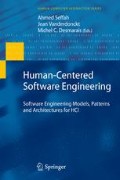Abstract
Recent investigation reveals that few usability enhancements can be easily incorporated into the existing design as they are only related to the design of UI; but many of which may be prohibively expensive. A more recent perspective on the usability of software systems is that making software more usable is a lot easier to do if the high-level architecture was designed with usability in mind. Hence, software architects should ponder usability before usability professionals are brought into the project, more specifically during the elicitation of functional requirements. Unfortunately, there is a scarcity of methods and guidelines with the scope to ensure that software developing corporations consider usability requirements in their architectural design activities. This chapter addresses this need and provides a more developed approach for architecting usable systems. A non-formal exercise reveals that this proposed methodology was well-received by participants with different knowledge of usability. They found the process not too onerous as it guided them in discerning the concerns that could have a real impact on the architecture.
Access this chapter
Tax calculation will be finalised at checkout
Purchases are for personal use only
Preview
Unable to display preview. Download preview PDF.
References
Artim, J. M. (1997). Integrating user interface design and object-oriented development through task analysis and use cases. ACM SIG CHI Bulletin, 30(4).
Bass, L. and John, B. E. (2003). Linking usability to software architecture patterns through general scenarios. Journal of Systems and Software, 66(3):187–197.
Ferre, X., Jursito, N., Moreno, A. M., and Sanchez, M. I. (2003). A software architectural view of usability patterns. In 2nd Workshop on Software and Usability Cross-Pollination: The Role of Usability Patterns (Interact), Zurich, Switzerland.
Folmer, E. and Bosch, J. (2004). Architecting for usability. Journal of Systems and Software, 70(1):61–78.
Folmer, E., van Gurp, J., and Bosch, J. (2003). Investigating the relationship between software architecture and usability. In Software Process - Improvement & Practice: Special Issue on Bridging the Process and Practice Gaps between Software Engineering and Human Computer Interaction.
Goldberg, A. and Robson, D. (1983). Smalltalk-80: The Language and its Implementation. Reading, MA: Addison-Wesley.
ISO/IEC (1998). ISO/IEC 9241-11: Ergonomic requirements for office work with visual display terminals (VDT)s—Part 11 Guidance on usability. ISO/IEC 9241-11: 1998 (E).
Pfaff, G., editor (1985). User Interface Management Systems. Springer-Verlag, New York. Proceedings of the IFIP/EG Workshop on User Interface Management Systems, Seeheim, FRG, Oct. 1983.
Phanouriou, C. (2000). UIML: A Device-Independent User Interface Markup Language. Ph.D. thesis, Vermont University.
Rafla, T., Oketokoun, R., Wiklik, A., Desmarais, M. C., and Robillard, P. N. (2004). Accommodating usability-driven changes in existing software architecture. In IASTED 8 th International Conference on Software Engineering and Applications (SEA), pages 150–154, Cambridge, MA.
Rafla, T., Robillard, P. N., and Desmarais, M. C. (2006). Investigating the impact of usability on software architecture through scenarios: A case study onWeb systems. Journal of Systems and Software, 79(3):415–426.
Rafla, T., Robillard, P. N., and Desmarais, M. C. (2007). A method to elicit architecturally sensitive usability requirements: its integration into a software development process. Software Quality Journal.
Seffah, A., Gulliksen, J., and Desmarais, M. C., editors (2005). Human-Centered Software Engineering: Integrating Usability in the Development Process. New York: Springer.
Seffah, A. and Hayne, C. (1999). Integrating human factors into use cases and objectoriented methods. Lecture Notes in Computer Science, 1743:240–250.
Author information
Authors and Affiliations
Editor information
Editors and Affiliations
Rights and permissions
Copyright information
© 2009 Springer Science+Business Media, LLC
About this chapter
Cite this chapter
Rafla, T., Desmarais, M.C., Robillard, P.N. (2009). Toward a Refined Paradigm for Architecting Usable Systems. In: Seffah, A., Vanderdonckt, J., Desmarais, M.C. (eds) Human-Centered Software Engineering. Human-Computer Interaction Series. Springer, London. https://doi.org/10.1007/978-1-84800-907-3_11
Download citation
DOI: https://doi.org/10.1007/978-1-84800-907-3_11
Publisher Name: Springer, London
Print ISBN: 978-1-84800-906-6
Online ISBN: 978-1-84800-907-3
eBook Packages: Computer ScienceComputer Science (R0)

